Remembering disability in our history
Singapore has come a long way as an inclusive society for disabled persons but as noted recently by Ms Cassandra Chiu, an advocate for the disabled, there is still much to be done. I think the discrimination that disabled people face also stems from how Singapore society has overlooked disability in our history.

Disability in our history reminds us of how we have previously excluded disabled people, how inclusion really started and reminds us not to make the same mistakes that we had in the past, writes the author.
Singapore has come a long way as an inclusive society for disabled persons but as noted recently by Ms Cassandra Chiu, an advocate for the disabled, there is still much to be done.
Writing in TODAY, Ms Chiu noted how many disabled people still feel excluded and discriminated against, adding that even organisations serving them do not have strong representation of the disabled in their management committees and boards.
I think the discrimination that disabled people face also stems from how Singapore society has overlooked disability in our history.
The building of the Mass Rapid Transit (MRT) in the 1980s is a case in point. Today it is uber-accessible, but we have forgotten how it excluded disabled people when it was first built. There were no elevators and disabled people could not use the MRT when it was launched in 1987.
It was only in the mid 1990s, after years of activism by disabled people, that the trains were made accessible.
When National Education was first introduced in Singapore in 1997, history was highlighted as a means to ensure that a young nation like Singapore would develop a shared sense of nationhood, through the building of a common identity based on lessons from the past.
History thus allows us to build a shared identity. It also allows us to understand how far we have progressed together, and provides valuable lessons as we seek to build a more inclusive society.
Looking at disability in our history reminds us of how we have previously excluded disabled people, how inclusion really started and how not to make the same mistakes that we had in the past.
But more importantly, remembering the past, as Confucius would note, allows us to better determine the future that we should take as we strive for inclusion.
Unknown to many, inclusivity in Singapore can be traced to 1981.
The late Ron Chandran-Dudley or Uncle Ron as I knew him, was instrumental in setting up an international organisation of disabled people — Disabled Peoples’ International — that laid the foundations for the United Nations Convention of Rights for Persons with Disability.
Uncle Ron was blind and believed in the self-representation of disabled people. He was relentless in advocating for the disabled and for them to take their equal place in society, in Singapore and worldwide.
Uncle Ron visited many countries in the immediate aftermath of the founding of Disabled Peoples’ International in Singapore in 1981 where he forged alliances and supported disabled persons to begin their own local organisations.
In Singapore, the advocacy of Uncle Ron, together with many others, represented a key moment as disabled people sought to stand on their own two feet. The setting up of Disabled People’s Association Singapore in 1986, a disabled-led organisation, represented the aspirations of the disabled to guide their own destinies.
THE PROBLEMS OF FORGETTING
Forgetting disability in our history also has other implications on current debates about inclusion. A big issue in recent months has been the employment of the disabled. One thing is clear in this debate — that disabled people want to work, but are unable to find jobs.
The (un)employment of disabled people has a history. In the 1970s and 80s, Singapore began to pay significant attention to this issue.
We invited experts from the United Nations and the International Labour Organisation, and commissioned reports on the best ways to increase the employment of disabled people.
In 1988, then Minister for Education Dr Tony Tan chaired the Advisory Council on Opportunities for the Disabled, with an entire section offering recommendations on disability employment.
As reported by the council, the civil service then employed 443 disabled people out of a total pool of 131,696 employees in 1984. In 2016, only 270 disabled people are employed out of a pool of 145,000 employees.
For a country that prides itself on being the best, history shows that our record on resolving the issue of disability employment is perhaps not one that we would be proud of.
To encourage more companies to employ disabled people, the civil service in Singapore needs to walk the talk and hire more disabled people.
As Prime Minister Lee Hsien Loong states at the launch of the Singapore Bicentennial, we need to turn to history and to look for ways that we can move forward together.
In our move to a more inclusive society, examining disability in our history has many lessons. We need to remember the ways in which we excluded disabled people.
We need to remember their call for self-representation. We need to recall how efforts today have a history. As we look to the future, we need to ensure that this history must not be forgotten.
Educating the next generation in our schools of disability in our history is a good place to start.
One thing is also clear from this history — that disabled people in Singapore have demanded their equal participation in society from the 1980s onwards.
And the best way to achieve inclusion is to ensure that disabled people are the ones driving this effort.
ABOUT THE AUTHOR:
Kuansong Victor Zhuang is pursuing a PhD in Disability Studies at the University of Illinois at Chicago, having obtained a Masters in History from the National University of Singapore where his research focused on the history of disability in Singapore. He previously worked for six years at SG Enable, the government-linked agency that helps disabled people.






